
Longfin snake eel (Pisodonophis cancrivorus), Cyrene Reef;
(Photo by Ria)
In the previous post, I talked about moray eels (F. Muraenidae), a group that is widespread in coral reefs and rocky shores throughout the tropics and warm temperate seas. It is a little puzzling that we don't encounter moray eels more often on our shore exploration trips, and I cannot recall if any of those who dive in our waters have ever encountered moray eels. However, there is a family of eels that we do encounter quite often on our shores, the snake eels (F. Ophichthidae).
Here in Singapore, the longfin snake eel and worm eel (Muraenichthys sp.) are spotted quite often on our trips, especially at night.


Left: Longfin snake eel, Sisters Islands;
(Photo by Ria)
Right: Worm eel, Sisters Islands;
(Photo by Marcus)
The sgbeachbum blog has 2 excellent videos of a longfin snake eel and worm eel.
We're not too sure about the exact identity of the worm eel which we spot quite often on our shores. The Wild Fact Sheet on snake eels lists the slender snake eel (Scolecenchelys macroptera) as being present in Singapore, under the old name of Muraenichthys macropterus. I suspect that this is the species we know as the worm eel, but I can't tell for sure. If only an ichthyologist could help us out.

Here's a picture of a preserved slender snake eel for comparison, taken from the excellent Fishes of Bitung site.
Snake eels are a large family of about 250 known species, found throughout the world in coastal tropical to warm temperate seas. Some species are known to enter freshwater, whereas for other species, the adults live in seawater but spawn in freshwater, like salmon; the longfin snake eel is 1 such species. Others live exclusively in freshwater environments.
While the maximum size for many snake eel species is unknown, several species are known to reach 1 metre in length. The giant of the family however is the serpent eel (Ophisurus serpens), which has been recorded attaining a length of 2.5 metres.

Serpent eel, Catalonia;
(Photo by ToniTofa)
Snake eels are very similar to moray eels, in that they are nocturnal predators, preying upon fish, cephalopods and crustaceans. Unlike moray eels however, which appear to prefer reefs and rocky shores, snake eels in general seem to have a preference for sandy and muddy habitats.
During the day, most species hide in burrows or bury themselves in the sand, leaving only the head exposed.
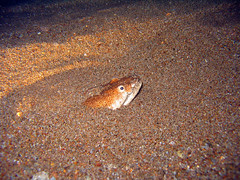
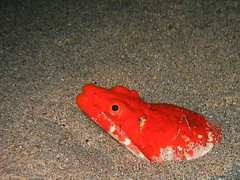

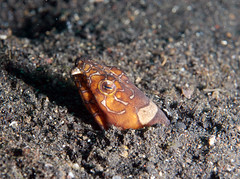
4 species of snake eel, in their characteristic daytime pose.
Upper left: Crocodile snake eel (Brachysomophis crocodilinus), Dumaguete;
(Photo by Arne Kuilman)
Upper right: Reptilian snake eel (Brachysomophis henshawi), Manado;
(Photo by Daniel, Daniel Kwok)
Lower left: Black-finned snake eel (Ophichthus altipennis), Sulawesi;
(Photo by rlpurkey)
Lower right: Napoleon snake eel (Ophichthus bonaparti), Lembeh;
(Photo by Arne Kuilman)
However, under the cover of darkness, they emerge and actively forage for prey.

Longfin snake eel with octopus prey, Sisters Islands;
(Photo by Ria)
Snake eels aren't as charismatic as their cousins the moray eels; most divers will only see their heads poking up from the seabed, and besides, most species are a dull grey or brown. However, there are some species which are very attractively patterned.
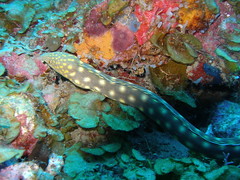

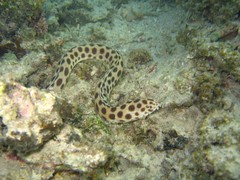
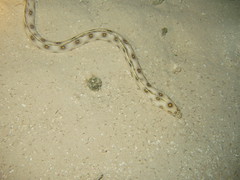
4 colourful species of snake eel.
Upper left: Sharptail snake eel (Myrichthys breviceps), Dominica;
(Photo by juliediver)
Upper right: Harlequin snake eel (Myrichthys colubrinus), Ningaloo Reef;
(Photo by Moon Fish)
Lower left: Spotted snake eel (Myrichthys maculosus), Mauritius;
(Photo by coolpix2006)
Lower right: Goldspotted snake eel (Myrichthys ocellatus), Honduras;
(Photo by adrianne323)
I'm wondering if the harlequin snake eel's appearance is a case of Batesian mimicry, and is an attempt to mimic the characteristic black bands found in the venomous sea kraits (Laticauda spp.). That the harlequin snake eel, like the sea kraits, is distributed over the Indo-Pacific is another interesting clue that suggests that what we are seeing here is an eel imitating a venomous snake in order to keep potential predators away.
Snake eels are consumed in many countries, although they do not appear to support major commercial fisheries. They are also used as bait for other species, and some species, especially attractively patterned species like the harlequin snake eel, are collected for the aquarium trade. In terms of requirements, snake eels are similar to moray eels in that they require plenty of space, will try to eat smaller tankmates, and care must be taken to ensure that they do not escape, with the additional requirement of plenty of fine gravel or sand that will allow the snake eel to bury itself.
There are a couple of other eel families which are utilised for food in the region, the conger eels (F. Congridae) and pike conger eels (F. Muraenesocidae), which I'll be discussing in my next post.
Part 1: Moray eels (Muraenidae)
Part 2: Snake eels (Ophichthidae) (this post)
Part 3: Conger eels (Congridae) and Pike conger eels (Muraenesocidae)
Part 4: Freshwater eels (Anguillidae)
Part 5: Spaghetti eels (Moringuidae) and false moray eels (Chlopsidae)
Part 6: Non-eels